
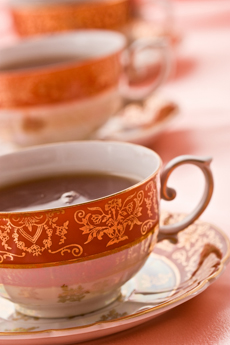
Fine tea should be drunk without milk or sweetener. Photo by A.G. Photographer | CSP.
January 2006
Updated January 2009
|
 |
How To Make Tea
Page 4: Making, Serving & Drinking Tea
This is Page 4 of a four-page article. Click on the black links below to visit other pages.
Making, Serving & Drinking The Tea
After the leaves have fully infused the water, gently stir the tea before pouring it into cups (or, if brewed in a cup, before drinking). Our favorite teapots have built-in strainers. If you have brewed loose leaves in a pot, you can hold a beautiful silver tea strainer between the spout of the pot and the teacup, to catch the leaves that escape. A proper tea service also provides a separate pot of hot water to dilute the brewed tea if it is too strong for a guest’s preference.
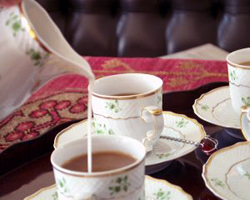 If all of the brewed tea is not served immediately, pour the remainder into a separate pot so that the leaves do not continue to infuse. If all of the brewed tea is not served immediately, pour the remainder into a separate pot so that the leaves do not continue to infuse.
The finest teas are drunk straight, with no additives (milk, sweetener, lemon), so that the connoisseur can appreciate the unique flavor nuances of the tea. A fine tea, brewed properly, is not bitter, weak or too strong and does not require enhancement. Asians, the original tea drinkers, look at Western additions to tea the way Westerners would look at Asians adding sugar and milk to wine.
- However, there certainly are many inferior teas that need enhancement to make them more palatable.
- Even with finer teas, from the onset Europeans added sweeteners, just as they sweetened the chocolate beverage that came from Mesoamerica at roughly the same time.
- Cream is too heavy an additive: The fat will mask the flavors of fine tea. If you want to use a milk product, whole milk is preferable.
- Green and white teas are traditionally served without milk, and also taste better without it, as do most herb teas.
- When adding both lemon and sugar, add the sugar first. The citric acid in the lemon prevents the sugar from dissolving.
Learn About Serving Tea
Here are some of our favorite books about serving tea. They’re inexpensive, and each is beautifully illustrated:
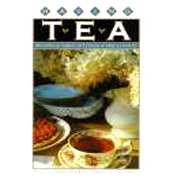 |
 |
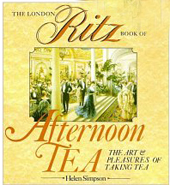 |
 |
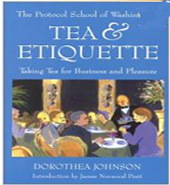 |
Having Tea: Recipes and Table Settings, by Tricia Foley and Catherine Calvert. A cookbook and style book with stunning locations plus recipes, menus, table settings, and serving ideas for tea. Go to tea at the Savoy Hotel in London, and a tea dance at London's Waldorf. You’ll want to have tea every day. Click here for more information.
|
|
The London Ritz Book of Afternoon Tea, by Helen Simpson. A book that captures the essence of this traditional British occasion and provides the reader with all the Ritz expertise in the ceremony as well as over 50 recipes, illustrated with passages from Dickens to Oscar Wilde and charming drawings. Click here for more information.
|
|
Tea and Etiquette: Taking Tea for Business and Pleasure, by Dorothea Johnson. The customs and courtesies associated with serving tea as an alternative to the business lunch or dinner, or as a social event. Written by one of America's foremost authorities on etiquette and protocol. Click here for more information. |
Learn More On TheNibble.com
Some of our most popular tea articles include:
Go To The Article Index Above
Lifestyle Direct, Inc. All rights reserved. Images are the copyright of their individual owners.

|





 If all of the brewed tea is not served immediately, pour the remainder into a separate pot so that the leaves do not continue to infuse.
If all of the brewed tea is not served immediately, pour the remainder into a separate pot so that the leaves do not continue to infuse. 

